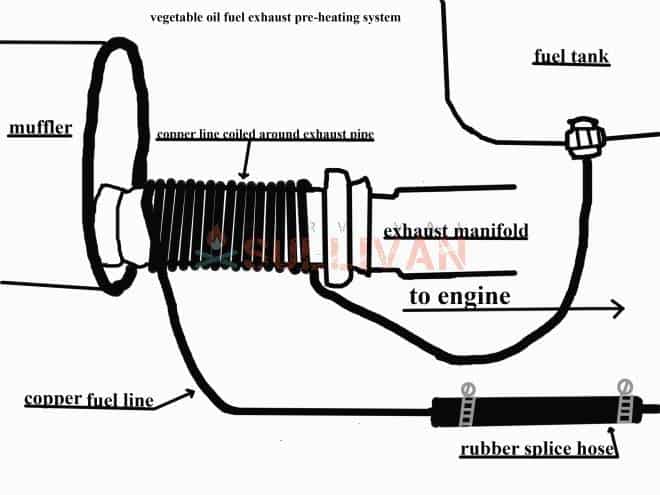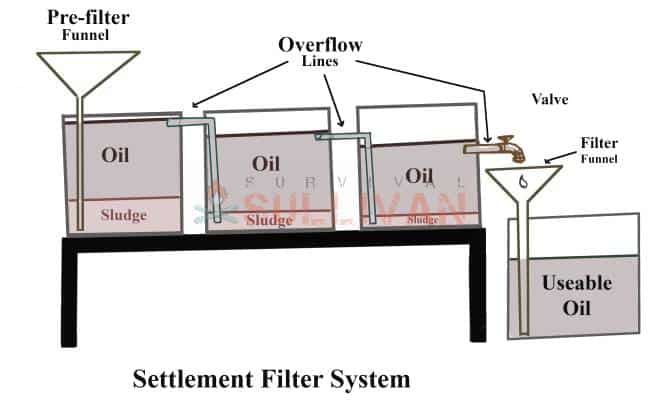Vegetable oil has many uses. It can be used to cook up some awesome delicious fried chicken, potato wedges (or chips I guess, if you’re in England), or other unhealthy yummy goodies. Vegetable oil can be used to oil stuff around the house too, no one likes squeaky hinges.
It can light your way when the power goes out and it can heat your house in the winter time. Seriously, it can. It can even run your diesel engines. What? Did he say it will run your diesel engines? Why yes, yes I did.
Self-Reliance
Using vegetable oil as fuel isn’t a new idea. It’s actually been “a thing” for over 100 years. The guy that invented the diesel engine, Rudolf Diesel, (no really, that’s his name) designed the engine to run on vegetable oil so that it would be appealing to farmers because, he reasoned, they would have a source of fuel right at home.
This allowed the farmers to not have to rely on outside sources for petroleum fuel and was supposed to be more economical for them. This brings us to the current time, when preppers and homesteaders are trying to become more self-sufficient and less reliant on outside sources for not just fuel, but everything.
SVO vs. PPO
When using vegetable oil for fuel it is referred to as either SVO (straight vegetable oil) or PPO (pure plant oil). Not only can SVO (straight vegetable oil) or PPO (pure plant oil) be used to run a diesel engine but it can also be used as heating oil for your home.
Author’s Note: On a smaller scale vegetable oil can also be used as lantern oil to provide light if the power goes out or if you are just trying to conserve or minimize your electric consumption. After all, if you are trying to provide your own power, cutting back on usage at any chance you get helps.
Veggie Power
Pretty much any diesel engine will run on SVO (straight vegetable oil) without any modifications, but in order to optimize the performance of using SVO (straight vegetable oil) for fuel a couple of simple modifications to your vehicle (truck or tractor), or generator (or whatever you are powering with your diesel engine) will help.
See an unmodified car run on used cooking oil here:
Atomization Maximization (Yes It’s Actually a Real Thing, Look It Up)
One issue with using straight vegetable oil in an unmodified engine is that the SVO has a higher viscosity (it’s thicker) than petroleum diesel fuel, and so it doesn’t atomize as well, especially in a cold environment. (Atomization is when the fuel is sprayed into the cylinder into a fine mist).
If the fuel doesn’t atomize properly it won’t burn properly and because of this it can cause the buildup of residue (gunky sludge) and carbonization of the residual SVO (hard, black gunky sludge). If you live in a hot climate this probably isn’t going to be a problem for you. However, if you live where it gets cold and snowy then you will need to address this issue. One way of correcting this problem is to preheat the SVO before it enters the combustion cylinder.
Preheating SVO
There are probably other methods of preheating the SVO but I am only aware of these two.
The Electric Heating Element Method
One method is to use an electric heating element on, or in, the tank to preheat the fuel. Preheating the SVO thins it and so allows it to become a finer mist. (Atomization maximization) Preheating the SVO to thin it also helps it flow through the fuel lines better.

The Exhaust System Method
The other method of preheating the SVO is to use the exhaust system to preheat the SVO. A hot exhaust pipe has a high enough temperature to heat the SVO but not a high enough temperature to be concerned about ignition of the fuel.
Using the exhaust to preheat the SVO can easily be accomplished by simply using copper tubing to re-route the fuel lines and then wrap the exhaust pipe with the copper tubing. (As seen in the diagram).
Author’s note: Combining both of these methods is probably the best way to do it. Using a tank heater to heat the SVO while the vehicle (or whatever device the engine is on, generator etc.) sits overnight and then having the fuel line coil around the exhaust to pre-heat it while the engine is in use.
Thickening in the Lines
These two methods of preheating the SVO can be used in whatever application the engine is being used for. While preheating the SVO solves the issue of atomization maximization (I swear this is a real thing, just look it up) it doesn’t solve the issue of fuel lines becoming clogged from the SVO thickening in cold weather.
Cold Starts
When the temperature drops the SVO becomes more viscous (it gets thicker). Because of this there can be issues with cold starts (the first starting for the day of the engine) due to residual SVO in the fuel lines thickening and blocking the flow.
One method to resolve this issue is to run a two tank system. One tank is for the SVO, the other tank is for petroleum diesel. You have to have a shutoff valve for each tank and you start and run the engine with petroleum diesel fuel until the exhaust warms the SVO then you switch tanks and run with the SVO.
A few minutes before you shut down the engine you switch tanks back to the petroleum diesel fuel to flush the lines of SVO. While this method does require petroleum diesel fuel it is to a minimum amount. Another method of clearing the lines of SVO is to shut off the fuel supply and let the engine run the last little bit of SVO out of the lines.
Long Term
While SVO can be used in an unmodified diesel engine, long term use will likely cause problems due to build up of residue in the system. Using the two tank system will increase the longevity as the SVO is flushed from the system every time the engine is run.
I saw one piece of information that said this problem can be solved by mixing SVO with petroleum diesel fuel, but whatever method you choose is up to you. I am of the mindset that using vegetable oil to run an engine would be based on the unavailability of petroleum diesel fuel so that makes blending it a moot point.
It seems that if you need to use SVO, whether it’s clean, new oil or used cooking oil then filtering it and using one of the conversion methods will be the way to go.

Filtering Waste Oil
There are hundreds of videos with hundreds of methods for filtering the used vegetable oil to make it fit for pouring into your fuel tank. Many of them require fancy, expensive pumps and centrifuges, but I found this guy’s videos and he makes the most sense to me. Simply let gravity do the majority of the work, let it settle. Just let it sit and let the solids and gunk settle to the bottom then extract the upper portion of oil and then filter it. Good to go.
Here’s a video of a simple method to clean used oil:
Heating Oil
Vegetable oil can be used to heat your home, but you can’t just go pouring it into the tank and “tada”. You have to get a special burner designed for waste oil and you have to preheat the oil (just like for the diesel engine) before it will work properly.
A tank heater will solve the problem of preheating the oil easily enough, but the burner is a different story.
Availability is a Consideration
A large waste oil burner can cost as much as or more than the whole heating and air system for a small house. Smaller units can be found for $1000 or so. You would have to have a really reliable source of waste oil/SVO to make it worth the expense of converting the unit to burn vegetable oil.
Oil Lantern
Oil lanterns were in use for literally thousands of years before electric lights took over. These simple devices used vegetable oil in a vessel with a wick to provide light for people’s homes.

Making a Simple Oil Lamp from a Jar
You can make a simple oil lamp yourself using a myriad of vessels you can find around the house. A simple jar with a screw on metal lid will make an excellent basic oil lamp.
Just fill the far, poke a hole in the center of the lid for a wick, screw the lid on. The wick will, well, it will wick the oil up (say that five times fast) and then you light it, that’s it.
If you want to get fancy you can put some type of glass globe on it to help make it more wind proof. If you have a candle stick with a glass chimney on it you can make something that it will fit on.
Sure, you can buy oil lamps at the store, but were talking about no more stores, no more eBay, no more online shopping at 3 am. We’re talking about making do with what you have.
Final Thoughts
The key to being self-sufficient and survival is to utilize what you have on hand. Repurposing items and using them for other than what they were intended for is a very important part of being self-contained.
Utilizing vegetable oil for more than cooking is part of this. You can start with clean oil, cook your food in it (and you can use it several times, restaurants do), then use it in your oil lamp or your generator engine.
Like I’ve said before, your most important tool in survival is your brain.

Eric Eichenberger is an avid outdoorsman, skilled marksman, and former certified range officer and instructor with nearly 40 years experience handling and repairing firearms.
A skilled craftsman with a strong love for working with his hands, Eric spent 20 years as a carpenter and custom woodworker in high end homes. As a gold and silversmith he has created hundreds of pieces of jewelry over the years using the lost wax casting method.
The grandson of humble country folk, he was raised with the “do it yourself” mentality and so is accustomed to coming up with unique solutions to problems utilizing materials at hand.

I do not understand, half the world’s population is starving and we use vegetables to make car fuel and people eat aditive oil extracts. Why not proceed normally? vegetable for people and oil for cars? I’m intrigued.
…Oil out of the ground is a finite resource, and makes diesel and petrol fuel, this makes it unsustainable;-VEGETABLE OIL is above ground, easily accessible from WASTES -just for the unenlightened, this happens AFTER people use it to eat food- and fuel can also be made from vege scraps, composts, and plastic… So the half starving world may have their fuel and eat it too…